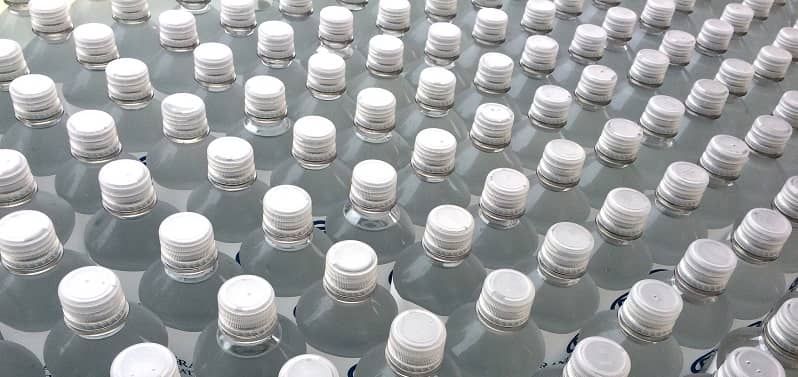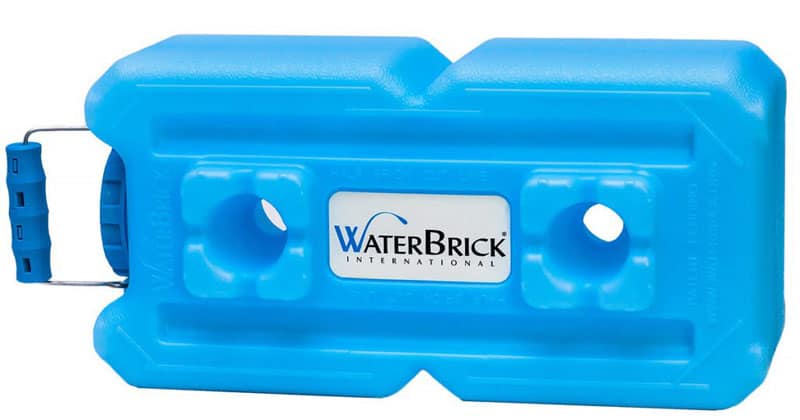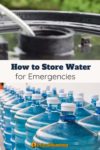Water should be your #1 focus when it comes to emergency preparedness.
This article will review how to store water for emergencies, including links to more detailed resources and the ins and outs of long-term water storage.
1. Decide How Much Water You Need to Store
FEMA recommends stockpiling at least 14 gallons of water per person, giving you 1 gallon daily for two weeks.
However, because most people use more than a gallon per day and water outages can last a long time, it is better to aim for a minimum of 60-120 gallons per person. You’ll also need water for your pets.
Read more about how much water to stockpile for emergencies.
2. Choose the Right Water Storage Containers
You must choose suitable containers for your emergency water stockpile. Using the wrong containers could cause leakage or contamination issues. Below are five options for storing emergency water.
Option 1: Bottled Water or Recycled Plastic Bottles

Many people buy bottled water or use recycled plastic bottles to store water. It is a quick, cheap, and easy way to build an emergency water supply. However, plastic bottles are not a good solution for long-term water storage.
Plastic bottles are biodegradable; over time, tiny holes will form in the bottles, and your emergency water will start leaking out.
Personally, it hasn’t happened to me, but I’ve heard stories of people checking on their stockpiles only to find water all over the floor. To prevent this, you’ll need to get rid of the plastic bottles every 6-24 months.
Another issue with storing water in plastic bottles is that the chemicals in the plastic will eventually leach into the water. Cheap plastic is also slightly porous, so your water can pick up tastes from the outside world – such as your musty basement.
These aren’t serious concerns during a disaster (bad-tasting water is better than no water!) but are something to consider for long-term storage.
Estimated Lifespan of Plastic Bottles
- Milk Jugs – 6 to 12 Months
- Store-Bought Water – 12 Months
- Soda Bottles – 12 Months
- Gatorade Bottles (or another thick plastic bottle)- 24 Months
Read more about this here: Does bottled water go bad?
Option 2: Water Storage Containers

Many plastic containers are specially designed to store water. These containers are made from thicker plastic, which doesn’t degrade like plastic bottles.
Water storage containers come in many sizes, ranging from 1-gallon jugs to large totes that can hold over 500 gallons. There are also many different shapes and features.
Read about the best emergency water storage containers.
Option 3: Storing Water in Jars
Another option is to store emergency water in glass jars. Jars don’t deteriorate like plastic, and there are no chemicals to worry about leaching into the water.
The main problem with using jars for storing water is that they are breakable. An earthquake or hurricane could destroy your whole stockpile, which defeats the point. Another issue is that you can only store small amounts of water in glass jars, so storage would be a problem.
Option 4: Water Bags/Pouches
Water bags or pouches are a relatively new product allowing hassle-free storage of limited amounts of water. They are only suitable for short-term water storage.
Read our guide to emergency water bags.
Option 5: Underground Storage Tanks
A fantastic long-term water storage solution is to get an underground tank. These can even be designed to connect to your home’s plumbing: as you use the water in the tank, it gets filled up again. In a water outage, you’d have an entire tank accessible. The obvious downside is that underground water tanks are expensive to install.
3. Keep Your Emergency Water from Going Bad
Water itself never goes bad and has an infinite shelf life. However, stored emergency water can get contaminated by algae, mold, or bacteria. You will need to sanitize containers before putting water in them. You may also want to sanitize the water itself.
How to Sanitize Water Containers
Regardless of which type of containers you use for your emergency water stockpile, you should sanitize them first. To do this:
- Mix a solution of 1 tsp of unscented bleach and 1 quart of water.
- Put the solution inside the water container
- Close the lid tightly and shake well.
- Let the bleach solution sit for at least 30 seconds before draining.
- Let the container air dry.
- Soak the lids/caps in the bleach solution separately. This will ensure that the area in the threads gets sanitized.
Treating Water before Storage
Some sources of water – such as untreated well water – contain microorganisms. If you leave the water sitting long enough, bacteria, mold, and algae can start growing. To prevent contamination, you’ll need to add bleach to the water before storing; add 2 drops of unscented liquid bleach per gallon of water.
Even though municipal tap water is chlorinated, many people still add bleach to it as an extra precaution against bacteria and algae.
There is also something called Water Preserver Drops, which you can add to water to prevent contamination. It will keep your drinking water safe for 5 years or more, so you don’t have to rotate as frequently.
4. Know Where to Keep Emergency Water
Emergency water should be kept in a cool, dark place. The reason for this is that heat and light cause algae growth. They also cause plastic storage containers to degrade.
You’ll also need to keep stored water away from things that smell bad or produce fumes, such as gasoline or chemicals.
Finally, you want to ensure the water is somewhere you can easily access during emergencies.
If you are short on space, read these tips for prepping in an apartment.
Storing Water in the Garage
The garage is a terrible place to store water. The main reason is that garages are subject to substantial temperature swings. Your water might freeze in winter, which could cause the storage containers to crack. Always leave at least 10% headroom in containers so frozen water can expand.
Also read – How to stop water from freezing outside
Garages can easily get 15 degrees F hotter than the outside temperature. The heat can cause plastics – especially cheap plastic bottles – to break down quickly.
There is also the issue of safety with garages. Garages can be easily broken into. They are typically the weakest part of a home and fail first during natural disasters. Don’t be surprised if your entire garage blows off during a hurricane or tornado.
In addition to these issues, garages are typically musty. All plastics are slightly porous, so eventually, the water will absorb the musty smells of your basement. It will probably still be safe to drink but taste terrible.
*Never store water directly on a concrete floor. Contrary to what many prepper sites say, chemicals from the concrete will not get into the water and contaminate it. However, dirt will accumulate around the bottoms of the water containers. The containers will be more susceptible to any temperature swings in the concrete. Rodents are also more likely to chew on plastic containers directly on the ground. So put all preps on pallets or elevated platforms.
Storing Water in the Basement
The basement is a bad place to store emergency water (though not as bad as the garage). As with your garage, basements are musty, and your water will absorb the foul odors and taste terrible.
Another issue with storing water in the basement is accessibility. If you live somewhere prone to flooding, you won’t be able to access your emergency water once the basement starts filling with water.
Storing Water in Your Vehicle
Don’t forget to put some emergency water in your vehicle, too. It’s not advisable to store cheap plastic water bottles in your car: your car gets too hot, and those cheap bottles will degrade quickly. Ensure you leave 10% headroom in containers to allow room for freezing.
I only keep 2.5 and 5-gallon water containers with spigots in my car. I reason that these are easier to carry and pour. I also have an empty Nalgene bottle in the trunk; I can fill this with water instead of trying to drink from a large container.
For more, read how to store water in a car.
5. Rotate Your Emergency Water
You’ll need to rotate your emergency water supply regularly. This will ensure that the water doesn’t start growing algae or other contaminants, so drinking is safe. Rotation also ensures that your water tastes fresh and doesn’t get a foul smell from the surrounding air or plastic containers.
How often should I rotate my emergency water?
You must rotate your emergency water every 6 months to 5 years. Cheap plastic bottles kept in a warm, bright place will need to be rotated every 6 months so they don’t start leaking.
Thicker plastic bottles (such as recycled Gatorade bottles) kept in a cool, dark place only need to be rotated every 24 months.
If you invest in quality water containers, add bleach to the water, and store it somewhere cool and dark, you’ll only need to rotate it every 5 years.
Emergency Water Rotation Tips:
- Label bottles: Write the date you bottled the water so you know when to rotate it.
- Check on your water supply every six months: Make sure there is no leakage or contamination.
- Swap out plastic bottles: If using bottled water or recycled plastic bottles, you’ll need to get rid of the bottles each time you rotate; put clean water in completely new bottles.
6. Have a Way to Treat Water
Even if you are stockpiling drinking water, you should still have an emergency water filter or purifier. If your water supply becomes contaminated, you can still safely drink it after treating it.
Likewise, if you run out of water, a purifier means you can gather water from other sources, like rainwater collected from downspouts, and safely drink it.
For more on this, read:
- Storing water in drums
- Water purification methods
- Best Emergency Water Filters
- How to Treat Water with Household Bleach
- Charcoal Water Filter



Diane…. I have followed your site for a number of years now and always found the information and answers you and your staff provide to be well researched, thought out and helpful. My question on this topic is what water testing kit do you recommend that will provide accurate results for use with a rainwater-stream harvesting / storage? My reasons for asking are: (1) I would like to be able to do before & after testing for comparison purposes (2) I sometimes distill and want to track the pH, etc. and if the SHTF, there won’t be any reliable services available to use.
Thank you.
Great information, carry on.
Water storage is likely the biggest issue if nothing else but for the sheer amount that’s considered adequate. Some ideas regarding adequacy, would require a dedicated room to keep enough. Then there’s rotation.
The most practical solution would be to ensure idiot politicians don’t get elected and screw this country up worse than it already is, followed by the underground tank that you draw through that gets refilled. However, that too will still require maintenance because of sediment, bacteria, etc… Yes, city water has sediment and bacteria. I think a well might make more sense if you’re fortunate enough to have a reasonable fresh-water table. You can treat a well if need be. Some areas may have natural springs or artesian wells. That’s the best. I grew up on a farm that had a spring that’s been flowing before the area was settled and it’s still flowing.
Too bad you can’t make powdered water.
I have a question regarding stored water. If the water you have stored came from a trusted source (your tap for instance) and is stored in approved containers such as sanitized glass, water storage bricks, approved barrels, or even gallon Gatorade bottles and has been properly stored regarding temperature, light and contaminants, why does it have to be rotated out. Why couldn’t you simply filter out any solid sediment (algae, mold, bacteria, mineral, etc.) that may / could present itself in the container by pouring it through three layers of coffee paper filters to remove the solid sediments. Then, bring that filtered water to a rolling boil for 3-5 minutes or distill it, followed by aerating it to introduce oxygen back into the water. The reason I ask is that this seems like it would be an easier way to be able to use the water you have collected and stockpiled, eliminates the need to stockpile and rotate more than a couple of gallons of chlorine (as it rapidly degrades below a usable level), and best of all saves the amount of water you need to collect. Please understand that I am just talking about “stored potable water” that comes from your home’s tap (Source: the City waterworks) and not how to purify water from other sources. Would love to hear your thoughts.
Great question Jim! The reason you *should* rotate stored water is because it gets gross. Even when it is stored “perfectly”, the water will still get nasty over time. Algae is a big problem. In plastic bottles, the water will quickly start to taste musty.
You are correct: you can just treat the water (filtering, bleach or boiling would work). BUT here are the problems with that:
1. Boiling the water requires you to have a stove + fuel. IMO, this is a huge waste of fuel. Plus, there are situations where it isn’t safe to light a stove, such as after an earthquake where there may be a gas line leak.
You could use bleach to treat water. But Bleach only has a shelf life of 1 year, so you’d have to constantly rotate that. Filtering with a 0.2 micron filter would work but can be a huge pain. Even if you are fine with the hassle of treating water, there’s the taste issue…
2. Treatment won’t remove bad tastes from water. Obviously this isn’t an issue in life/death situations. But most disasters aren’t life/death. Speaking from experience, it’s really gross to drink water which has been sitting around for a year. You can mix it with flavor packets (Kool-Aid type things) to hide the taste, but it’s still nasty. *Charcoal water filters will remove bad tastes from water, but they have short shelf lives and can be expensive. I’d rather save them for removing dangerous chemicals from water!
Here’s what I do for my water storage:
I’ve got most of it stored in larger tanks. These ones I don’t rotate through often. Yes, the water gets nasty but it’s there for a true SHTF situation where taste isn’t a priority. I’d have to treat it to make it safe for drinking.
I also have some water stored in smaller jugs. It’s enough for approximately two days. This water gets rotated through every 6 months or so. This is the water I use for small emergencies or when the water gets turned off for some reason. This way I at least can drink my morning coffee even when there isn’t water. 🙂
Isn’t boiling water prior to drinking one of the best ways to have clean water?
Yes, unless there are also chemicals in the water. Then boiling will actually concentrate the chemicals. For example, this is a problem in places where agricultural runoff can get into the water supply. But, if you were to stockpile water in bottles and it got a bit funky after sitting around for years, boiling would make it safe to drink. It would still taste nasty though! Better to rotate the water occassionally!
Remember to rotate your bleach as well. Sodium Hypochlorite based bleach degrades pretty quickly depending on storage and temperature.
Bleach that is 6 months old may have its power cut by half or more. I know this from experience as I was assigned to assay gallon containers of commercial product for strength that were going to be diluted and used to sterilize cooling tower water.
Exactly! We talk about that and bleach storage options here: https://www.primalsurvivor.net/does-bleach-expire/